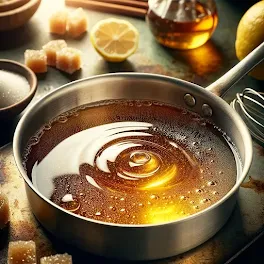Origin Story: Kanafeh with Cream Filling
Kanafeh is a beloved Middle Eastern dessert, renowned for its rich, creamy filling and crispy, buttery crust. Traditionally, it is filled with cheese and soaked in a sweet syrup, making it a decadent treat that is often enjoyed during special occasions and celebrations. My version of Kanafeh, with a berry and cream filling, offers a fresh twist on this classic, infusing it with vibrant flavors and a touch of elegance.
Historical Roots
Kanafeh (also spelled Knafeh or Kunafa) has its roots in the Levant region and is particularly popular in countries like Lebanon, Palestine, Jordan, and Syria. The origins of this dessert can be traced back to the 10th century, where it was first made in the kitchens of the Fatimid Caliphs in Egypt. The name "Kanafeh" is believed to derive from the Arabic word "kanaf," meaning to protect or cover, referring to the pastry that covers the filling.
Traditionally, Kanafeh is made with thin strands of shredded phyllo dough called kataifi, layered with a cheese filling and baked until golden and crispy. It is then soaked in a fragrant sugar syrup, often infused with rose or orange blossom water. The result is a dessert that is both crispy and creamy, sweet and aromatic.
Cultural Significance
Kanafeh is more than just a dessert; it is a symbol of celebration and hospitality in Middle Eastern culture. It is often served during festive occasions such as Ramadan, Eid, and weddings. Each region has its own variations, with different types of cheese and methods of preparation. The communal aspect of making and sharing Kanafeh adds to its significance, bringing families and friends together to enjoy this delightful treat.
Personal Connection
My journey with Kanafeh began during a family trip to Lebanon. I was captivated by the sight of pastry shops displaying large trays of Kanafeh, their golden crusts glistening with syrup. The combination of textures and flavors was unlike anything I had ever tasted. Inspired by this experience, I decided to create my own version of Kanafeh, incorporating the freshness of berries and the creaminess of mascarpone cheese.
The idea of adding a berry and cream filling came from my love for summer fruits and the desire to create a lighter, more refreshing version of this classic dessert. The tartness of the berries balances the sweetness of the syrup, while the creamy mascarpone adds a luxurious touch. This twist on Kanafeh retains the essence of the traditional dish while offering a new and exciting flavor profile.
Recipe Evolution
Creating the perfect Berry and Cream Kanafeh involved several trials and adjustments. I found that using a combination of fresh and dried berries provided the best balance of flavors and textures. The mascarpone cheese filling needed to be smooth and rich, complementing the crunch of the kataifi pastry.
I also experimented with different syrups, eventually settling on a light honey syrup infused with a hint of lemon zest. This syrup enhances the natural sweetness of the berries and adds a subtle citrus note, tying the dessert together beautifully.
Sharing the Tradition
Today, Kanafeh with a Twist: Berry and Cream Filling is a favorite at family gatherings and special occasions. It’s a dessert that brings a touch of elegance and freshness, surprising and delighting those who taste it. Each bite is a celebration of the rich culinary heritage of the Middle East, infused with the vibrant flavors of summer berries.
Ingredients
Instructions
- Preheat the oven to 175°C (350°F).
- In a saucepan, combine mixed berries, 1/2 cup sugar, cornstarch, and lemon juice.
- Cook over medium heat until the mixture thickens. Stir in vanilla extract and let cool.
- In a large bowl, separate the kataifi dough and mix with melted butter until well coated.
- Press half of the dough into a greased baking dish.
- In a bowl, mix ricotta cheese with heavy cream until smooth.
- Spread the cream mixture over the kataifi dough in the baking dish.
- Add the cooled berry mixture on top of the cream layer.
- Cover with the remaining kataifi dough, pressing gently.
- Bake for 30 minutes or until golden brown.
- n a saucepan, combine water, remaining sugar, honey, and rosewater.
- Bring to a boil and simmer for 10 minutes.
- Pour the hot syrup over the baked kanafeh.
- Let it soak for a few minutes before serving.
Pro Tips:
- Fresh or Frozen Berries: Both fresh and frozen berries can be used. If using frozen, ensure they are thawed and drained.
- Layering: Press the kataifi dough firmly for a crispier crust.
Secret Tips
- Extra Flavor: Add a pinch of ground cardamom to the berry mixture for a hint of spice.
- Cheese Variation: Substitute ricotta with mozzarella for a more traditional texture.
Serving Options
Health Benefits:
- Berries: Rich in antioxidants and vitamins.
- Ricotta Cheese: A good source of protein and calcium.
Variations & Customization Options:
- Nutty Kanafeh: Add a layer of crushed pistachios or walnuts between the cream and berry layers.
- Citrus Twist: Add orange zest to the syrup for a citrusy flavor.












